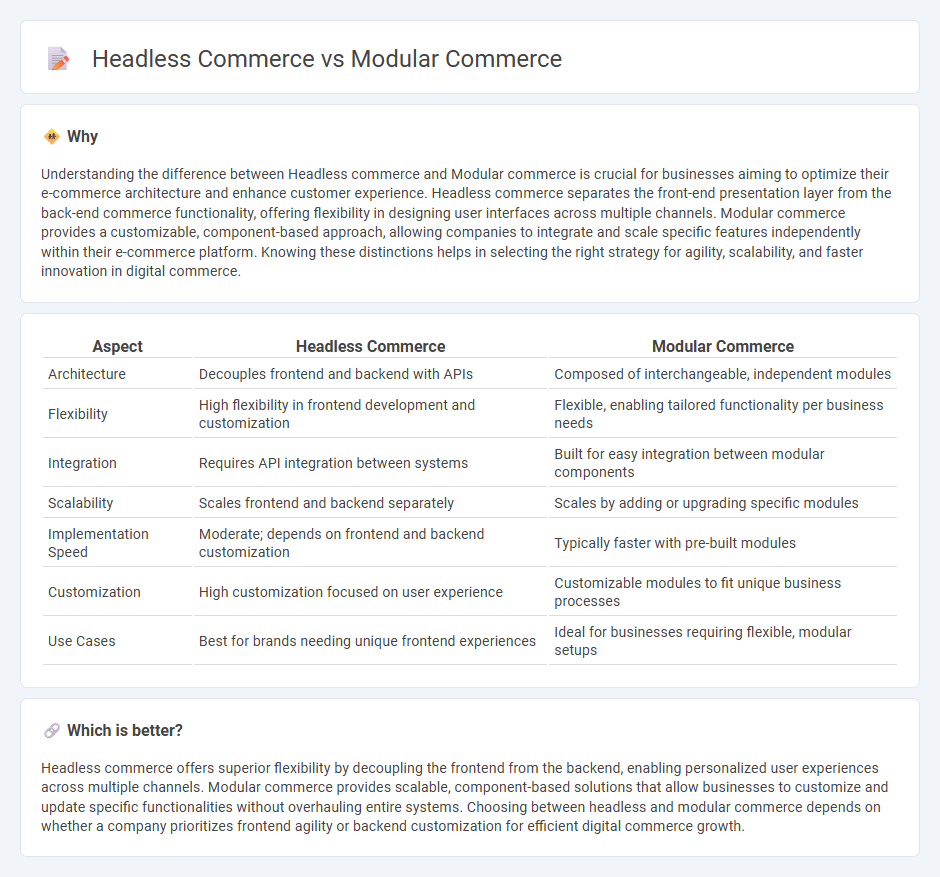
Headless commerce separates the front-end presentation layer from the back-end e-commerce functionality, enabling businesses to deliver seamless omnichannel experiences across web, mobile, and IoT devices. Modular commerce breaks down the e-commerce platform into independent, interoperable modules that can be customized and scaled individually to meet specific business needs. Explore the distinctions and benefits of headless versus modular commerce to optimize your digital retail strategy.
Why it is important
Understanding the difference between Headless commerce and Modular commerce is crucial for businesses aiming to optimize their e-commerce architecture and enhance customer experience. Headless commerce separates the front-end presentation layer from the back-end commerce functionality, offering flexibility in designing user interfaces across multiple channels. Modular commerce provides a customizable, component-based approach, allowing companies to integrate and scale specific features independently within their e-commerce platform. Knowing these distinctions helps in selecting the right strategy for agility, scalability, and faster innovation in digital commerce.
Comparison Table
| Aspect | Headless Commerce | Modular Commerce |
|---|---|---|
| Architecture | Decouples frontend and backend with APIs | Composed of interchangeable, independent modules |
| Flexibility | High flexibility in frontend development and customization | Flexible, enabling tailored functionality per business needs |
| Integration | Requires API integration between systems | Built for easy integration between modular components |
| Scalability | Scales frontend and backend separately | Scales by adding or upgrading specific modules |
| Implementation Speed | Moderate; depends on frontend and backend customization | Typically faster with pre-built modules |
| Customization | High customization focused on user experience | Customizable modules to fit unique business processes |
| Use Cases | Best for brands needing unique frontend experiences | Ideal for businesses requiring flexible, modular setups |
Which is better?
Headless commerce offers superior flexibility by decoupling the frontend from the backend, enabling personalized user experiences across multiple channels. Modular commerce provides scalable, component-based solutions that allow businesses to customize and update specific functionalities without overhauling entire systems. Choosing between headless and modular commerce depends on whether a company prioritizes frontend agility or backend customization for efficient digital commerce growth.
Connection
Headless commerce separates the front-end presentation layer from the back-end e-commerce functionality, enabling flexible and customized user experiences across various channels. Modular commerce complements this by breaking down e-commerce platforms into independent, interoperable modules that can be individually developed, updated, or replaced. Together, headless and modular commerce empower businesses to create scalable, adaptable, and personalized commerce solutions that respond rapidly to market demands and technological advancements.
Key Terms
Architecture
Modular commerce architecture enables businesses to pick and choose best-of-breed components, allowing seamless integration and flexibility tailored to specific needs. Headless commerce decouples the front-end presentation layer from the back-end commerce engine, promoting customizable user experiences across multiple channels via APIs. Explore further to understand how each architecture impacts scalability, development speed, and customer engagement.
Flexibility
Modular commerce offers unparalleled flexibility by enabling businesses to select and integrate individual components tailored to specific needs, promoting agile adaptation to market changes. Headless commerce decouples the front-end presentation layer from the back-end, allowing seamless customization of user experiences across multiple channels. Explore detailed comparisons to understand which approach best suits your e-commerce strategy for maximizing flexibility.
Integration
Modular commerce offers a flexible approach by allowing businesses to select and integrate individual components, enabling tailored solutions specific to their needs, while headless commerce separates the front-end presentation layer from the back-end functionality, facilitating seamless API-driven integration across multiple channels. Integration in modular commerce often involves combining best-of-breed services for payment, inventory, and customer management, whereas headless commerce emphasizes uniform data flow and real-time synchronization through robust API ecosystems. Explore deeper insights into how integration strategies differ to optimize your e-commerce architecture effectively.
Source and External Links
How Modular Commerce Works (w/ Examples) - fabric Inc. - Modular commerce builds ecommerce platforms from interconnected components, enabling scalable, flexible, and marketer-friendly content management across channels without constant developer involvement.
Comparing Modular and Headless Commerce - SCAYLE - Modular commerce allows independent, flexible modules handling specific ecommerce functions to be added or removed easily, improving agility and enabling best-of-breed custom solutions for omnichannel retailers.
What Is Modular Commerce? Headless vs. Modular Ecommerce ... - Shopify - Modular commerce breaks ecommerce platforms into specialized, autonomous components that can be orchestrated and managed independently, offering customization and responsiveness suitable for mature ecommerce businesses.
 dowidth.com
dowidth.com